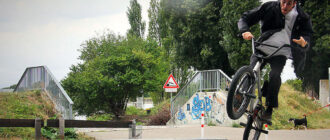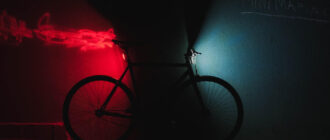- Purchase and evaluation criteria for bicycle helmets for babies
- Helmet size
- Weight
- Closure
- Color
- What is special about a bicycle helmet for babies and what advantages does it offer?
- What are the types of helmets for babies?
- Hard shell helmet for babies
- Softshell - helmet for babies
- Micro shell helmet for babies
- For whom is a bicycle helmet for babies suitable?
- What are the alternatives to a bicycle helmet for babies?
- What should I look for in bicycle helmets for my baby?
- Which helmet size is suitable for my baby?
- How should a bicycle helmet fit babies?
Cycling is becoming more and more popular nowadays, but still many cyclists do without a helmet, even though it can save your life in an emergency. Especially for babies, this omission can be very harmful. A helmet for your baby (and for you) is always a good idea.
But if you’re not sure what to look for in a bike helmet for your baby, then you’ve come to the right place. In our article we explain the advantages of a helmet, the differences to a regular helmet, how to determine the perfect size and much more!
The most important in brief:
- When you are on the road with your baby, you should definitely put helmet on your baby and yourself, as it can protect you from more serious injuries in case of a fall.
- When choosing the right bike helmet for your baby, you need to pay attention to several factors, such as, the size, the weight and, to a lesser extent, the design of the helmet. Especially the fit and the closure are very important.
- In today’s market there are three different types of bicycle helmets, which have their own advantages and disadvantages: the micro shell, the soft shell and the hard shell helmet.
Purchase and evaluation criteria for bicycle helmets for babies
When choosing the right bike helmet for your baby, you should pay attention to a few factors. We have briefly listed and explained the most important ones here. In our guide - part we go into the respective points in more detail.
- Size of the helmet
- Weight
- Closure
- Color
Helmet size
As for the sizes, there is not much choice. The sizes go from XS to S. These are the official sizes for babies. You should measure your baby’s head every time before you buy a new helmet, even if you think it hasn’t grown much. Baby heads grow very quickly.
Another important factor in the selection is the fit of the helmet.
The helmet should be tight, but at the same time not too tight, otherwise it can be very uncomfortable.
It should also not slip in any case. Therefore, it is a good idea to put the helmet on and wear it for a while before you buy it.
You should also pay attention to the wearing comfort. This means that the helmet should be padded on the head and chin. It should also ideally have an adjustment system to be adaptable to any head shape.
Weight
A good bicycle helmet needs a low dead weight. This applies doubly to bicycle helmets for babies, as they do not yet have such well-developed neck muscles.
The helmet should therefore be very light and weigh only between 200 - 300 grams.
Especially with babies, you should make sure that they do not wear the helmet for too long at a time, because their neck is not yet accustomed to such a weight.
Closure
One of the most important factors you need to pay attention to when buying is the closure of the bike helmet. Just like a normal helmet, the closure should click or snap when you close it. Unlike a normal helmet, your baby should not be able to open it accidentally.
Of course, the bike helmet should also fit tightly and not be easy to loosen. With the closure you should make sure that the chin strap is always easy to adjust and that there is a pad for the chin under the closure, so that it comes to a good wearing comfort.
Color
An additional criterion that is important in the selection is the color of the bike helmet with which your baby and you will jet through the area. Thanks to the dozens of colors and different motifs, choosing the right helmet can be very difficult.
If it is possible, you should leave the choice to your baby. This way you know that your baby will like the helmet visually and will identify with it more easily, which can make it a little easier to put on later.
What is special about a bicycle helmet for babies and what advantages does it offer?
The first question you’re probably asking yourself now is, what’s the difference between a normal and a bike helmet for babies? Apart from the size, a bicycle helmet for babies must offer more protection than a regular helmet, since a baby’s head is not yet fully developed. In addition, most bicycle helmets for babies are somewhat flattened at the back, so that it is more comfortable for your baby to lean back relaxed in a child seat or bicycle trailer.
|
|
|
|
Also a big difference is the wearing comfort. A bike helmet for babies must be more comfortable to wear than a regular helmet, because babies have less patience with a helmet that is uncomfortable to wear.
What are the types of helmets for babies?
Nowadays you can find a few different types of bike helmets on the market. We have listed the three most popular ones, what they are made of, what are the advantages and disadvantages of each type and whether they are suitable for your baby or not.
Hard shell helmet for babies
Hard shell helmets consist of two different parts: the outer helmet shell and the inner strap system, on which the outer shell, which is made of hard plastic, sits. With the existing chin strap you can fix the helmet to your head.
These helmets have a few different adjustment systems: Velcro, plastic ratchet or wheel.
|
|
|
|
As briefly mentioned, a hard-shell helmet was not designed for cycling, but as alternatives to other types, you can go ahead and use it.
Softshell - helmet for babies
These helmets have a thin outer shell of polycarbonate, which is connected to a shock-absorbing EPS - core (expanding polystyrene). In the event of a fall, the EPS - core absorbs the impact.
|
|
|
|
Although this type has long been widely used as children’s helmets, many experts say that soft shell - helmets are no longer state of the technology and therefore should not be used.
Micro shell helmet for babies
Micro shell helmets are best suited for babies. These usually have a hard shell with a plastic cover and have a core made of hard foam.
Most models have additional pads that are attached to the hard foam with Velcro.
|
|
|
|
This type of helmet is definitely the best for your baby. Not only in terms of safety it is optimal, but also because of the comfort and ease of cleaning you should buy your baby such a helmet.
For whom is a bicycle helmet for babies suitable?
There is currently no legal minimum age from which you can ride your bike with your baby on the streets. A good sign is when you notice that your baby can already sit upright by himself. This is usually possible from the 6th month. By then, your baby’s neck muscles are strong enough for a bicycle helmet. Before that, you should never take your baby on your bike.
In the beginning you have the choice between a child seat and a bicycle trailer.
In the beginning, a bicycle trailer is better because you are driving your baby around in an almost lying position. This makes it much easier for your baby to get used to a bicycle helmet, because it is much more relaxed to lie than to sit.
What are the alternatives to a bicycle helmet for babies?
If for some reason you are looking for an alternative to a bike helmet for your baby, we also came across other sports helmets during our research. For example, you have riding helmets or ski helmets that you could theoretically use as a substitute.
However, we advise you not to use ski or riding helmets instead of bike helmets for your baby.
It is of course better for your baby to wear a helmet than not, but if you have the possibility to buy a professional and adapted helmet for your little darling, we would strongly advise you to do so. These are also designed for falls from the bike and to protect against injuries.
What should I look for in bicycle helmets for my baby?
When buying a helmet, you should pay attention to the most important safety features. The first thing you need to consider is the fit of the helmet. It should not be too loose and at the same time not too tight, so that it does not become uncomfortable for your baby during the ride. A good and soft padding helps with this. The best thing is to have the bicycle helmet for your baby adjusted to its head shape.
Also an important point in terms of safety and comfort is the weight of the helmet. A good baby helmet should weigh less than 300 grams, be made of hard plastic and have cold foam.
Because there is no uniform size, there may be small variations from manufacturer to manufacturer, but generally baby helmets come in sizes XS and S. Therefore, before you go to buy the helmet, you should first measure your baby’s head and compare it with the different helmet sizes. For this we have put together a little guide below to help you a little.
Another important point that you must pay attention to when buying a helmet is that the bicycle helmet has a good closure. This should best click or snap when putting on and can not be accidentally opened by your baby.
The closure should also not be too tight, but not too loose on the chin. Of course, a good helmet must also be able to be worn at dusk or in the dark, which is why it must be equipped with an LED - light or reflectors.
What many people do not know is that a good bike helmet needs several vents (preferably 7 to 9) to provide good air circulation in summer and reduce sweating under cap in winter. You can also tell the quality of a bike helmet by these vents.
If you notice that the shell can be easily detached from the hard foam at the slots, you should continue your search and choose a better helmet.
Which helmet size is suitable for my baby?
| Helmet size | Head circumference | Age |
| XS | 44 – 49 cm | 0 – 3 years |
| S | 46 – 51 cm | 2 – 7 years |
Of course, there can be fluctuations here. Since there are many manufacturers and thus many different helmets, you need to measure again in any case before you go on the way to buy your favorite a helmet. The easiest way to measure is with a tape measure from the neck to the middle of the forehead.
How should a bicycle helmet fit babies?
After you have found the perfect bike helmet, the only question is how to put it on your baby.
Here is a brief summary of the most important points:
- Measure the circumference of the head with a tape measure one centimeter above the eyebrows.
- Put on the helmet, screw it on at the back and let the baby wear it for a few minutes; the helmet must not fall off.
- Do not close too tightly on the chin
- At the sides, the straps must form a triangle under the ear
We hope that our guide has answered all the questions you have about the perfect bike helmet for your baby, you now know which helmet is the best and how to put it on your baby correctly.







